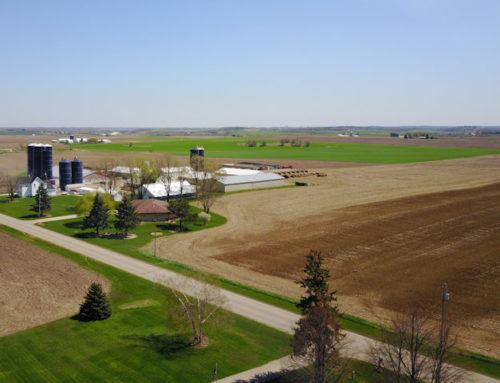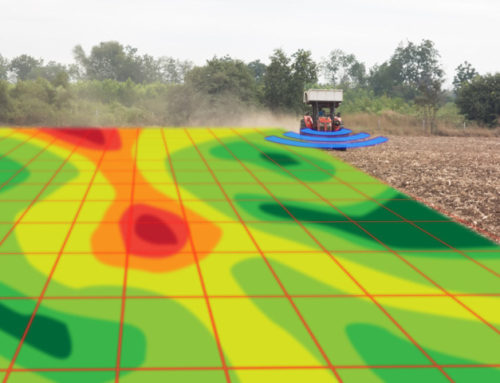WI DNR NR 151 Runoff Management Standards is a large document (link). It covers runoff pollution performance standards for agricultural facilities as well as non−agricultural facilities and transportation facilities. This web site focuses on geophysical applications, pertaining primarily to agricultural facilities. Consequently, excerpts of the document that discuss bedrock, fractures, groundwater, geophysics, or direct conduits are displayed below in bold face text. While karst is not defined or mentioned in the section for agricultural facilities, one suspects it is part of the program, given the definition of direct conduits and the concern about fractures and other paths for groundwater flow.
Since the following information is fragmented, it may be misconstrued. Thus, the reader is clearly responsible for referencing the original entire current form of the text. The document states it is “Published under s. 35.93, Wis. Stats., by the Legislative Reference Bureau” And “Updated on the first day of each month. Entire code is always current. The Register date on each page is the date the chapter was last published.” The version referenced in this discussion is “ Register June 2018 No. 750.”
Why are agricultural facilities part of NR 151?
Because the US EPA total maximum daily loads standards are managed by NR 151.075 Silurian bedrock performance standards. The document states:
NR 151.005 Performance standard for total maximum daily loads.
A crop producer or livestock producer subject to this chapter shall reduce discharges of pollutants from a livestock facility or cropland to surface waters if necessary to meet a load allocation in a US EPA and state approved TMDL.
(1) A crop producer or livestock producer subject to this chapter shall use the best management practices, conservation practices, or technical standards established under ch. ATCP 50 to meet a load allocation in a US EPA and state approved TMDL.
(2) If compliance with a more stringent or additional performance standard, other than the performance standards contained in this chapter, is required for crop producers or livestock producers to meet a load allocation in a US EPA and state approved TMDL, the department shall use the procedure in s. NR 151.004 to promulgate the more stringent or additional performance standard before compliance is required.
History: CR 09−112: cr. Register December 2010 No. 660, eff. 1−1−11.
Below one will find portions of the NR 151 document that discusses definitions and sections that are thought to apply to this web site.
Definitions that reference bedrock, fractures, groundwater, geophysics, or direct conduits.
“Closed depression”
means a topographical basin where water ponds to a seasonal high water mark, has no external drainage, and drainage may occur either through direct conduits to groundwater or low areas where water ponds and infiltrates into the groundwater. Closed depressions may be identified using topographic maps and visual interpretation, ArcGIS tools, or other methods. A seasonal high water mark may include, but is not limited to, areas that collect and retain water for extended time periods (days or weeks) that result in areas of reduced or no crop growth.
“Direct conduits to groundwater”
means wells, sinkholes, swallets, fractured bedrock at the surface, mine shafts, non− metallic mines, tile inlets discharging to groundwater, quarries, or depressional groundwater recharge areas over shallow fractured bedrock.
“Direct runoff”
includes any of the following: (a) Runoff from a feedlot that can be predicted to discharge a significant amount of pollutants to surface waters of the state or to a direct conduit to ground water. (b) Runoff of stored manure, including manure leachate, that discharges a significant amount of pollutants to surface waters of the state or to a direct conduit to ground water. (c) Construction of a manure storage facility in permeable soils or over fractured bedrock without a liner designed in accordance with s. NR 154.04 (3). (d) Discharge of a significant amount of leachate from stored manure to waters of the state.
“Infield bedrock verification”
means determining bedrock depth using available data which may include well construction reports, location of drill cores or other subsurface investigations, location of quarries and natural bedrock outcrops, geophysical investigations, and uneven crop growth patterns that are linked to fracture traces in the field.

Wisconsin DNR’s NR 151 protects everyone’s groundwater.
“Silurian bedrock”
means the area in Wisconsin where the bedrock consists of Silurian dolomite with a depth to bedrock of 20 feet or less. This area comprises portions of the following counties: Brown, Calumet, Dodge, Door, Fond du Lac, Kenosha, Kewaunee, Manitowoc, Milwaukee, Outagamie, Ozaukee, Racine, Sheboygan, Walworth, Washington, and Waukesha. Areas where Silurian bedrock occurs in Wisconsin can be identified by the most current NRCS, Wisconsin Geological Natural History Survey, department of agriculture, trade and consumer protection, department of natural resources, county maps, or infield bedrock verification methods.
“Site that is susceptible to groundwater contamination”
under s. 281.16 (1) (g), Stats., means any one of the following:
(a) An area within 250 feet of a private well.
(b) An area within 1000 feet of a municipal well.
(c) An area within 300 feet upslope or 100 feet downslope of a direct conduit to groundwater.
(d) A channel that flows to a direct conduit to groundwater.
(e) An area where the soil depth to groundwater or bedrock is less than 2 feet.
(f) An area where the soil does not exhibit one of the following soil characteristics:
1. At least a 2−foot soil layer with 40% fines or greater above groundwater and bedrock.
2. At least a 3−foot soil layer with 20% fines or greater above groundwater and bedrock.
3. At least a 5−foot soil layer with 10% fines, or greater above band bedrock.
Note: See s. NR 151.002 (32) for definition of percent fines.
“Soil texture”
means the surface texture of the Silurian bedrock soil map unit. Also see, Table 1. Silurian Bedrock Maximum Liquid Manure Application Rates below.
“Water quality management area” or “WQMA”
means the area within 1,000 feet from the ordinary high water mark of navigable waters that consist of a lake, pond or flowage, except that, for a navigable water that is a glacial pothole lake, the term means the area within 1,000 feet from the high water mark of the lake; the area within 300 feet from the ordinary high water mark of navigable waters that consist of a river or stream; and a site that is susceptible to groundwater contamination, or that has the potential to be a direct conduit for contamination to reach groundwater.
NR 151.004 State targeted performance standards.
Implementation of the statewide performance standards and prohibitions in this chapter may not be sufficient to achieve water quality standards under chs. NR 102 to 105 or groundwater standards under ch. NR 140. In those cases, using modeling or monitoring, the department shall determine if a specific waterbody or area will not attain water quality standards or groundwater standards after substantial implementation of the performance standards and prohibitions in this chapter. If the department finds that water quality standards or groundwater standards will not be attained using statewide performance standards and prohibitions but the implementation of targeted performance standards would attain water quality standards or groundwater standards, the department shall promulgate the targeted performance standards by rule.
Note: Pursuant to s. 281.16 (2) (a) and (3) (a), Stats., the performance standards shall be designed to meet state water quality standards. Note: Pursuant to s. 281.16 (3), Stats., the department of agriculture, trade and consumer protection shall develop or specify the best management practices, conservation practices or technical standards used to demonstrate compliance with a performance standard developed under s. NR 151.004. History: CR 00−027: cr. Register September 2002 No. 561, eff. 10−1−02; CR 09−112: am. Register December 2010 No. 660, eff. 1−1−11.
NR 151.075 WISCONSIN ADMINISTRATIVE CODE 406
NR 151.075 Silurian bedrock performance standards.
(1) All crop producers and livestock producers that mechanically apply manure directly or through contract or other agreement to cropland or pasture areas that meet the definition of Silurian bedrock under s. NR 151.015 (17) must comply with this section.
(2) Mechanical manure application may not cause the fecal contamination of water in a well.
(3) Manure may not be mechanically applied on areas of cropland or pastures that have 24 inches or less of separation between the ground surface and apparent water table.
(4) Manure must be applied in conformance with a nutrient management plan that meets the requirements under all the following:
(a) The plan must be consistent with s. NR 151.07.
(b) The plan must be consistent with NRCS Technical Standard 590, dated December 2015.
Note: Copies of the Wisconsin Natural Resources Conservation Service (“NRCS”) Nutrient Management Standard 590, dated December 2015, including the Technical Note (TN−1) referenced in the standard, may be inspected at the offices of the department, the Wisconsin Department of Agriculture, Trade and Consumer Protection, county land conservation departments and the legislative reference bureau, Madison Wisconsin. NRCS 590 ( and TN−1) is also available electronically at: efotg.sc.egov.usda.gov/references/public/WI/590_Standard−(2015−12).pdf and efotg.sc.egov.usda.gov/references/public/WI/Conservation_Planning− TN−1.pdf.
(c) The plan must be designed and implemented consistent with this section to manage manure so as to reduce the risk of pathogen delivery to groundwater and prevent exceedances of groundwater water quality standards.
(d) The plan must use NRCS soil survey maps/information or other methods as a planning tool to identify Silurian bedrock within or adjacent to cropland and pastures.
(5) Manure may not be mechanically applied on croplands or pastures until infield bedrock verification or Silurian bedrock map information is used to identify areas where the Silurian bedrock soil depth is less than 5 feet. If infield bedrock verification uses drill cores or other subsurface investigations, they must be backfilled with soil within 72 hours of being created.
Note: Silurian bedrock map information developed by the department of agriculture, trade and consumer protection and/or department of natural resources, may be used alone or in combination to meet the requirements of this section. Note: Silurian bedrock map information, available from the University of Wisconsin department of soil science, can be found at snapplus.wisc.edu/maps/ .
(6) Manure may not be mechanically applied on croplands or pastures where the Silurian bedrock soil depth is less than 5 feet until such fields are evaluated and ranked for risk of pathogen delivery to groundwater. Areas determined to have a high risk for pathogen delivery to groundwater must be avoided or must be lowest priority for manure application.
(7) Mechanical application of manure and headland stacking of manure is prohibited on soils with 5 feet or less to Silurian bedrock when soils are frozen or snow covered.
(8) Mechanical application of manure is prohibited within Silurian bedrock having soil depths less than 5 feet when rainfall greater than one inch is forecast within 24 hours of planned application.
(9) Mechanical application of manure is prohibited for soils with less than 2 feet to Silurian bedrock.
(10) For soils with 2 to 3 feet to Silurian bedrock, all the following apply:
(a) No mechanical application of solid manure unless all the following are met:
1. Solid manure is incorporated within 72 hours to no more than 4 inches below ground.
2. At least one of the following is implemented:
a. Solid manure is applied at a rate no greater than 15 tons/ acre/year, or the rate that supplies the crop nitrogen recommendation from UW A2809, whichever is less.
b. Solid manure is applied in compliance with UW A2809 and within 10 days of the planting date or applied on a perennial or established crop.
c. Solid manure is composted or treated to reduce pathogen levels via practices to a fecal coliform bacteria density of less than 500,000 colony−forming units or most probable number per gram total solids on a dry weight basis. Note: Copies of the University of Wisconsin — Extension publication A2809 Nutrient Application Guidelines for Field, Vegetable, and Fruit Crops in Wisconsin, dated 2012 (A2809) may be inspected at the office of the department, the Wisconsin Department of Agriculture, Trade and Consumer Protection and the legislative reference bureau, Madison, Wisconsin. A2809 is also available electronically at: http://learningstore.uwex.edu/assets/pdfs/A2809.pdf.
(b) No mechanical application of liquid manure unless all the following are met:
1. Pre−tillage is completed, unless exempt under par. (c) or (d).
2. Liquid manure is injected or incorporated within 24 hours to no more than 4 inches below ground, unless exempt under par. (c).
3. At least one of the following is implemented: a. Total liquid manure application is applied in compliance with UW A2809, or limited to Table 1, whichever is less, to prevent hydraulic overloading of the soil.
Table 1. Silurian Bedrock Maximum Liquid Manure Application Rates
| Soil Texture | 2 to 3 Feet Depth (gal/ac/yr) | 3 to 5 Feet Depth (gal/ac/wk) | 5 to 20 Feet Depth (gal/ac/wk) |
| Sand | 6,750 | 6,750 | 13,500 |
| Sandy Loam | 13,500 | 13,500 | 27,000* |
| Loam | 13,500 | 13,500 | 27,000* |
| Silt Loam | 13,500 | 13,500 | 27,000* |
| Clay Loam | 13,500 | 13,500 | 20,000* |
| Clay | 6,750 | 6,750 | 13,500 |
*It is anticipated that this rate would exceed the UW A2809 annual (crop year) application rate.
(c) Pre−tillage, incorporation or injection is not required if cropland or pastures meet long term no−till or have a perennial or established crop. Each surface application of liquid manure must not exceed 6,750 gallons per acre.
(d) Pre−tillage is not required if demonstrated to the department that a field cannot meet s. NR 151.02 over an eight−year crop rotation using a combination of the following practices: tillage, crops, contouring, filter strips, or cover crops.
(11) For soils with 3 to 5 feet to Silurian bedrock, all the following apply:
(a) No mechanical application of solid manure unless all the following are met:
1. Incorporated within 72 hours to no more than 6 inches below ground.
2. At least one of the following is implemented:
a. Manure is applied in accordance with UW A2809 annual application rate, or at a rate of 15 tons/acre/year, whichever is less. b. Manure is applied in compliance with UW A2809 and within 10 days of the planting date or applied on a perennial or established crop. c. Manure is composted or treated to reduce pathogen levels via practices to a fecal coliform bacteria density of 500,000 colony−forming units, or most probable number per gram total solids on a dry weight basis. Note: Copies of the University of Wisconsin — Extension publication A2809 Nutrient Application Guidelines for Field, Vegetable, and Fruit Crops in Wisconsin, dated 2012 (A2809) may be inspected at the office of the department, the Wisconsin Department of Agriculture, Trade and Consumer Protection and the legislative reference bureau, Madison, Wisconsin. A2809 is also available electronically at: http://learningstore.uwex.edu/assets/pdfs/A2809.pdf
(b) No mechanical application of liquid manure unless all the following are met:
1. Pre−tillage is completed unless exempt under par. (c) or (d).
2. Liquid manure is injected or incorporated within 24 hours to no more than 6 inches below ground, unless exempt under par. (c).
3. At least one of the following is implemented:
a. Total liquid manure application is applied in compliance with UW A2809, or limited to sub. (10) (b) 3. Table 1 rates, whichever is less, to prevent hydraulic overloading of the soil.
b. Liquid manure is applied in compliance with UW A2809 and within 10 days of the planting date or applied on a perennial or established crop.
c. Liquid manure is treated to substantially reduce pathogen levels via practices to a fecal coliform bacteria density of less than 500,000 most probable number or colony−forming units per 100 milliliter sample. Note: Copies of the University of Wisconsin — Extension publication A2809 Nutrient Application Guidelines for Field, Vegetable, and Fruit Crops in Wisconsin, dated 2012 (A2809) may be inspected at the office of the department, the Wisconsin Department of Agriculture, Trade and Consumer Protection and the legislative reference bureau, Madison, Wisconsin. A2809 is also available electronically at: http://learningstore.uwex.edu/assets/pdfs/A2809.pdf.
(c) Pre−tillage, incorporation or injection is not required if cropland or pastures meet long term no−till or have a perennial or established crop. Each surface application of liquid manure must not exceed 6,750 gallons per acre.
(d) Pre−tillage is not required if demonstrated to the department that a field cannot meet s. NR 151.02 over an eight−year crop rotation using a combination of the following practices: tillage, crops, contouring, filter strips, or cover crops.
(12) For soils with 5 to 20 feet to Silurian bedrock, all the following apply:
(a) No mechanical application of liquid manure unless all the following are met:
1. Pre−tillage is completed unless exempt under par. (b) or (c).
2. Liquid manure is injected or incorporated within 24 hours to no more than 6 inches below ground, unless exempt under par. (b).
3. At least one of the following is implemented:
a. Total liquid manure application is applied in compliance with UW A2809, or limited to sub. (10) (b) 3. Table 1 rates, whichever is less, to prevent hydraulic overloading of the soil.
b. Liquid manure is applied in compliance with UW A2809 and within 10 days of the planting date or applied on a perennial or established crop.
c. Liquid manure is treated to substantially reduce pathogen levels via practices to a fecal coliform bacteria density of less than 500,000 most probable number or colony−forming units per 100 milliliter sample. Note: Copies of the University of Wisconsin — Extension publication A2809 Nutrient Application Guidelines for Field, Vegetable, and Fruit Crops in Wisconsin, dated 2012 (A2809) may be inspected at the office of the department, the Wisconsin Department of Agriculture, Trade and Consumer Protection and the legislative reference bureau, Madison, Wisconsin. A2809 is also available electronically at: learningstore.uwex.edu/assets/pdfs/A2809.pdf.
(b) Pre−tillage, incorporation or injection is not required if cropland or pastures meet long term no−till or have a perennial or established crop. Each surface application of liquid manure must not exceed 10,000 gallons per acre.
(c) Pre−tillage is not required if demonstrated to the department that a field cannot meet s. NR 151.02 over an eight−year crop rotation using a combination of the following practices: tillage, crops, contouring, filter strips, or cover crops. Note: Silurian bedrock map information for soils with 5 to 20 feet to Silurian bedrock, developed by the department of agriculture, trade and consumer protection and/or department of natural resources, may be used alone or in combination to meet the requirements of this section.
(13) Mechanical manure applications are prohibited within any of the following:
(a) 1000 feet of a community water system as defined in s. NR 811.02.
(b) 250 feet of a private water system or a non−community water system as defined in s. NR 812.07.
(c) An area within 300 feet upslope or 100 feet downslope of a direct conduit to groundwater as defined in s. NR 151.002 (11m).
(d) 100 feet of a concentrated flow channel that leads to a water system included in par. (a) or (b) or direct conduit to groundwater in par. (c).
(14) Mechanical manure applications are prohibited on or within 100 feet of Silurian bedrock in a closed depression unless the manure is injected or incorporated within 24 hours or prior to precipitation capable of producing runoff, whichever comes first. The prohibition of mechanical application of manure does not apply to areas following long term no−till practices or with a perennial or established crop.

Avoid concentrated flow channels that drain to a closed depression in Silurian bedrock.
(15) No surface application of manure on slopes of 6 percent or greater in cropland and pasture areas that have concentrated flow channels that drain to a closed depression in Silurian bedrock, unless the material is incorporated within 24 hours or prior to precipitation capable of producing runoff, whichever comes first. The prohibition of surface application of manure does not apply to areas following long term no−till practices or with a perennial or established crop.
(16) Practices must retain land applied manure on the soil where they are applied with minimal movement to maintain setback distances specified in subs. (13) and (14).
History: CR 17−062: cr. Register June 2018 No. 750 eff. 7−1−18; corrections in (10) (b) 1., 2., (11) (b) 1., 2., (12) (a) 1., 2., (13) (intro.), (d), made under s. 35.17, Stats., Register June 2018 No. 750.







